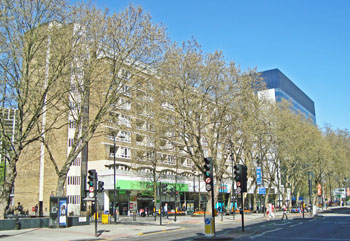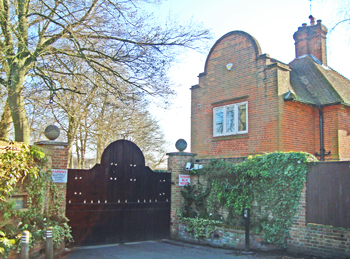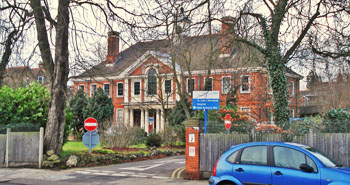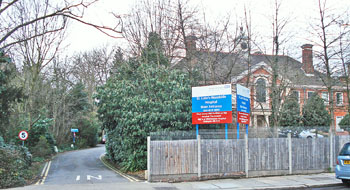Psychiatric
The first St Luke's Hospital for Lunatics opened in 1751 in an old converted building, the Foundry, in Windmill Hill, Upper Moorfields, leased from the authorities in the City of London. It had been founded the previous year by six people - Dr. Thomas Crowe, a physician; Richard Speed, a druggist of Old Fish Street; William Prowting, an apothecary of Tower Street; James Sperling and Thomas Light, two merchants of Mincing Lane; and Francis Magnus. The group was concerned about the abuse of inmates within the nearby Bethlehem Royal Hospital (which by this time was unable to meet the demand for admissions) and also perceived a need to distinguish between permanent and temporary forms of insanity , such as nervous breakdown.
The Hospital took its name from the new parish of St Luke's. It was the second hospital to be established especially for the poor mentally ill, the first being the afore-mentioned Royal Bethlehem Hospital, founded in 1247, and known familiarly as 'Bedlam'.
By 1753 the Hospital had 57 'curable' patients (lunatics) and, by the following year 70, all looked after by a staff of six - the keeper and his wife and two male and two female attendants. In 1754 the Hospital began to admit 'incurable' patients.
When the lease of the Foundry was about to expire, the Hospital Committee found it was unable to renew it on acceptable terms. Therefore, 3 acres of land in Old Street were leased from the Governors of St Bartholomew's Hospital, part of a 6-acre piece of land containing the Peerless Pool, a swimming bath constructed in 1743. Work began on the new site in 1782.
At the beginning of 1787 the patients were moved to the larger, purpose-built Hospital in Old Street, on the northwest corner of Providence Road. (The building work was not completed until the following year.) Considered to be one of the finest buildings in London at that time, it had been made possible by a generous donation of £30,000 bequeathed by Sir Thomas Clarke, a former Master of the Rolls, in his will (the total cost of the building had been £55,000).
The interior was less grand. The patients were housed in single cells, which had no heating. They slept on wooden bedsteads with loose straw (those considered incurable were only given straw). Many of the windows were not glazed but had iron grates, and shutters which were closed at night. The Hospital had two 'airing yards' - gardens for use as exercise yards - one for male and one for female inmates. The most dangerous patients were kept inside the building or locked in their cells. The basement contained large baths for cold water treatments (they were used until 1856). 'Lunacy' was believed to be a temporary and curable condition, and treatment consisted of a large cold plunge bath 'to shake the lunatics out of their insanity'. Restraint was sometimes used as a punishment to 'encourage' patients to behave in an orderly manner. Violent patients were often anchored to the wall by straps or placed in a strait waistcoat (straitjacket), but the Hospital had a reputation for more enlightened and humane treatment of lunatics than other similar institutions. The only medical treatments were principally anti-spasmodics, emetics and purgatives.
By 1812 there were 300 patients.
After 1830 attempts were made at categorization of mental patients, and occupational therapy began to be provided from 1833. By this time the ratio of patients to staff was 7:1 and methods of restraint were still employed.
In 1841 the newly established London Commissioners in Lunacy considered the building unsuitable (similiar institutions were being moved out into the countryside), but lack of funds prevented such a move for St Luke's. In 1842 a chapel was built for the use of the inmates. By 1844 there were 177 patients, 93 of whom were designated 'curable' and 84 'incurable'. From 1862 the distinction between 'lunacy' and other forms of insanity ceased to exist and St Luke's Hospital became a mental hospital in the modern sense.
In 1871 the Hospital Governors debated the possibility of selling the Old Street site, which had greatly increased in value, and building a larger, modern hospital outside of London. Negotiations began with St Bartholomew's Hospital, who owned the land, concerning division of the money once the building had been sold. The negotiations stalled and began again in 1877.
In 1893 the Hospital acquired a second site: Nether Court at St Lawrence-on-Sea, near Ramsgate. The manor house in 12 acres of land was leased for the benefit of convalescent female patients. It could accommodate 15-16 patients and 6 staff, including the Matron. (The Hospital bought Nether Court in 1901 but sold it in 1921 on grounds of cost).
In 1910 the Hospital Governors bought Welders House with its 100 acre estate on the border of the Chiltern Hills, as well as the 35-acre Jordans Farm (which was sold the following year to the Society of Friends), with the intention of building a convalescent home there (the plan never materialised). From 1911 until 1916 the House was used for convalescing certified patients, but it was an isolated site with no transport.
In 1915, during WW1, an unexploded shell from an anti-aircraft gun fell into a bedroom at the southern end of the Old Street building, but no-one was hurt. In 1916 the building was finally sold to the Bank of the England, with a financial agreement satisfactory to St Bartholomew's Hospital. (It became the St Luke's Printing Works, printing banknotes until 1958, when the Works were relocated to Debden in Essex. From 1920 to 1922 it also housed the Bank's gold smelting operation. The building was demolished in 1963 to make way for a shopping centre).
The second St Luke's Hospital (Old Street) closed in February 1917 and the 182 patients were discharged or transferred to other institutions. While the building was empty, bombs from a German airship fell through the roof and two storeys.
During the war there was no possibility of building a third hospital, but the Welders estate continued in use as a convalescent home for women with mild nervous maladies. In 1917 Welders Orchard (11-3/4 acres) and a field of 6-3/4 acres were purchased. Welders House was loaned to the War Office in 1918 for use as a Home of Rest for nurses in the Armed Forces suffering from the strain of the war.In 1920 Welders Wood, another 5 acres, was bought. The House was returned to the Governors of St Luke's, who reopened it in 1922. It finally closed in 1927 and remained empty until 1940 when the estate was leased out to a married couple who wished to make it into a private nursing and convalescent home. However, the tenants failed to make the business successful and Welders was leased to the Sisters of the Bon Secours in 1942; it became a branch of the St Joseph Nursing Home in Beaconsfield until April 1947. The Governors of St Luke's decided to reopen the house as a country branch for convalescing patients and those with mild neuroses, but it was decided to close it again in October 1948.
In 1922 a suggestion that the Foundation should establish a psychiatric unit in cooperation with a general hospital led to its funding an out-patient clinic and ward at the Middlesex Hospital. The clinic treated patients with psychoneurosis, drug or alcohol addiction, dementia praecox, paranoia and early acute psychosis. The ward block opened later in the same year, with two 3-bedded wards, enabling patients with nervous and mental disorders to be treated in a general hospital. (This arrangement with the Middlesex Hospital continued until 1938).
In 1928, with the proceeds from the sale of the Old Street building, the Governors purchased three adjacent Victorian villas in Woodside Avenue, Muswell Hill. The villas - Norton Lees (bought for £5000), Roseneath (£5500) and Lea Wood (£7500) - occupied a 6-3/4 site near Highgate Woods and were the only residences in Woodside Avenue. Their grounds stretched back as far as Grand Avenue. Work began to convert the site into a 50-bedded hospital for nervous diseases. Low-level ward blocks (one for 30 female and one for 20 male patients) were built, as well as an administration block and treatment and kitchen blocks. Norton Lees was enlarged and became the Nurses' Home.
The status of St Luke's Hospital by the 1930s was complicated and confusing. Although it was named as a Hospital, it was in fact a charity which owned some property and supported some institutions. Its properties consisted of the Welders estate and the Woodside Avenue houses in Muswell Hill. The institutions it supported were the Woodside Hospital and the 6-bedded ward at the Middlesex Hospital. (The charity's head offices were at 19 Nottingham Place, W1, from where it also ran a private nursing service which had begun in 1912. A similiar service was established also in Leeds, but both closed when the Woodside Hospital opened).
The third St Luke's Hospital was officially opened in November 1930 by Princess Helena Victoria as the Woodside Nerve Hospital. It had 12 patients and provided modern methods of treatment for organic nervous and mental disorders - alcoholism, drug addiction, Meniere's syndrome, cephalalgia (headaches) and 'senile changes' - as well as functional syndromes - anxiety, depression, hysteria, elation, neurasthenia (nervous breakdowns), paranoia, schizophrenia and psychotic behaviour.
In 1928 another villa - 28 Grand Avenue - was purchased for use as a Nurses' Home for the night staff.During WW2 the Hospital was evacuated but in 1940 it became part of the Emergency Medical Service, treating male and female officers for neuroses and mild psychoses. It was renamed the St Luke's Woodside Hospital for Functional Nervous Disorders. In the same year a delayed-action bomb fell on the lawn; the site was evacuated and it exploded 8 hours later with no casualties. Lea Wood was enlarged to create another ward and 28 Grand Avenue was also used for patients, who received prolonged narcosis as treatment, as well as narco-analysis. Many of the D-day casualties suffered from acute exhaustion and anxiety.
In 1945, when it became evident that a national health service was inevitable and that specialist hospitals would be linked to teaching hospitals, the Governors sought to re-establish links with the Middlesex Hospital. In 1948, on joining the NHS, the Hospital became the St Luke's-Woodside Hospital, the in-patient branch of the Department of Psychological Medicine of the Middlesex Hospital.
In 1952 it had 74 beds (7 of which were private). It was enlarged to 100 beds in order to meet the requirements of teaching hospital status. The Foundation's funds were transferred to the Middlesex Hospital.
In 1964 the Noel Harris Wing - for acutely disturbed psychiatric patients - opened and, in 1968, the Simmons House, for adolescent patients with drug dependency.
In 1974, when the Hospital had 80 beds, it ceased to be administered by the Middlesex Hospital and came under the auspices of the North East Thames Regional Health Authority. In 1982 it transferred to the Bloomsbury District Health Authority until 1993, when it joined the newly formed Camden and Islington Community Health Services NHS Trust.
Present status (January 2009)
Since 2002 the Hospital has been administered by the Camden and Islington Mental Health NHS Trust (now NHS Foundation Trust). The Trust plans to close three wards, moving the acute beds from Haringey to Camden. This has prompted fears that the Hospital will close, but the Trust stated in January 2009 that 50 beds will remain on site for residential and rehabilitation services.
Update: January 2011
The Hospital closed in 2010. The remaining few in-patients had been transferred to a new ward at St Pancras Hospital in 2009.
Update: March 2013
The 6-acre site has been sold for £26m to the Hanover Housing Trust, who plan to build an innovative housing development of 200 homes, 70% of which will be for people aged over 55 years.
Update: September 2018
The new development has been named Woodside Square.

The original site of St Luke's Hospital in Old Street now contains modern housing and shops.

Welders House (above and below) became a convalescent home for the Hospital from 1911 until 1927. It was Grade II listed is 1984.


The Administration Block of St Lukes-Woodside Hospital, built in 1928. It was Grade II listed in 2009.

The main entrance to the Administration Block.

The entry drive to the Hospital.
Following his arrest for the murders a public inquiry was held to establish why such a potentially dangerous person had been released from St Luke's-Woodside Hospital.
Dubbed the Camden Ripper, Hardy was jailed for life.
Black N 2006 Walking London's Medical History. London, Royal Society of Medicine Press.
French CN 1951 The Story of St Luke's Hospital 1750-1948. London, William Heinemann.
Gay K 2002 St Luke's Hospital celebrates 250 years. Hornsey Historical Society Bulletin 43, 12-13.
Hamilton Hogben G 1952 Report of the Medical Officer of Health. London, Borough of Hornsey, 52.
www.aim25.ac.uk
www.british-history.ac.uk
www.britishlistedbuildings.co.uk
www.camdennewjournal.com
www.haringey.gov.uk
www.studymore.org.uk
www.uclh.nhs.uk
Return to home page